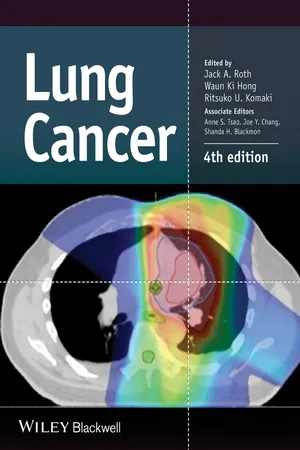
Lung Cancer
Jack A. Roth, Waun Ki Hong, Ritsuko U. Komaki, Jack A. Roth, Waun Ki Hong, Ritsuko U. Komaki
- English
- ePUB (mobile friendly)
- Available on iOS & Android
Lung Cancer
Jack A. Roth, Waun Ki Hong, Ritsuko U. Komaki, Jack A. Roth, Waun Ki Hong, Ritsuko U. Komaki
About This Book
The best and most concise single source for state-of-the-art diagnosis and treatment of lung cancer – newly revised, updated, and expanded. Lung cancer has long been the number-one cause of death from cancer every year and the third most frequently diagnosed after breast and prostate cancers. In 2010, about 15% of all cancer diagnoses and 30% of all cancer deaths were due to lung cancer. Needless to say, there is a great need for more rapid advancements in diagnosis and treatment of this devastating disease.
Here is the comprehensively revised, updated, and expanded edition of the well-established, evidence-based reference book that deals with the most recent advances in lung cancer prevention, screening, diagnosis, research, and treatment for the clinician. Edited and authored by leading authorities in the field, this Fourth Edition of the highly regarded Lung Cancer is better than ever –featuring nine new chapters along with seven re-formatted ones that are nearly brand new in content and approach. It covers Smoking Prevention and Cessation; Molecular Profiling; Somatic Genome Alterations in Human Lung Cancers; Management of Multi-Focal Bronchioloalveolar Carcinoma (BAC); Primary Tracheal Tumors; Predictive Tumor Biomarkers for EGFR Inhibitors; Non-Small Cell and Small-Cell Lung Carcinoma; and more.
This Fourth Edition of Lung Cancer:
- Provides the very latest research in the identification of biomarkers to predict a high risk for developing lung cancer – vital for implementing screening, diagnosis, and prevention strategies
- Presents the newest lung cancer staging system, as well as updated and cutting-edge surgical and radiation therapy techniques that make local tumor control more effective and less invasive while sparing normal tissues
- Discusses combined modality therapy and new chemotherapeutic agents which are yielding higher response rates and improved survival when used in the adjuvant setting or concurrent with highly sophisticated radiation or proton treatment
- Offers novel and emergent approaches to preventative, diagnostic, and therapeutic modalities with an emphasis on the best evidence available from the latest studies and clinical trials
With almost half of the revised and updated content being brand new, Lung Cancer, Fourth Edition, is an important and vital resource for all medical professionals and students involved in the care and treatment of those struck with this catastrophic illness.
Frequently asked questions
Information
CHAPTER 1
Smoking Prevention and Cessation
Overview
Introduction
| Cancer | Acute myeloid leukemia Bladder Cervical Esophageal Gastric Kidney Laryngeal Lung Oral cavity and pharyngeal Pancreatic |
| Cardiovascular diseases | Abdominal aortic aneurysm Coronary heart disease (angina pectoris, ischemic heart disease, myocardial infarction, sudden death) Cerebrovascular disease (transient ischemic attacks, stroke) Peripheral arterial disease |
| Pulmonary diseases | Acute respiratory illnesses –Pneumonia Chronic respiratory illnesses –Chronic obstructive pulmonary disease –Respiratory symptoms (cough, phlegm, wheezing, dyspnea) –Poor asthma control –Reduced lung function in infants exposed (in utero) to maternal smoking |
| Reproductive effects | Reduced fertility in women Pregnancy and pregnancy outcomes –Premature rupture of membranes –Placenta previa –Placental abruption –Pre-term delivery –Low infant birth weight Infant mortality (sudden infant death syndrome) |
| Other effects | Cataract Osteoporosis (reduced bone density in postmenopausal women, increased risk of hip fracture) Periodontitis Peptic ulcer disease (in patients who are infected with Helicobacter pylori) Surgical outcomes –Poor wound healing –Respiratory complications |